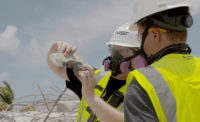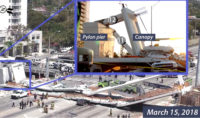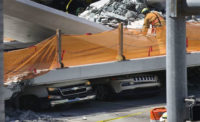The search for possible clues into the collapse of Champlain Towers South, and the corresponding hunt for a possible buyer of the site of the tragedy in Surfside, Fla., both moved forward notably on Aug. 11.
In the morning, just as the National Institute of Standards and Technology (NIST) was publicly detailing its approach to examining the site of the Champlain Towers South collapse in Surfside, news of a letter of interest from a possible “stalking horse” bidder eyeing a potential $110- to $120-million purchase of the property was being announced in the Miami courtroom of Judicial Court Judge Michael Hanzman.
Hanzman, who is overseeing the legal case related to the fate of the property and compensation of victims, called the news from Michael Fay of Avison Young—which is leading the site’s potential sale—as the “best news I’ve heard so far today,” adding: “That’s fantastic.”
The judge’s positive reaction was boosted after less positive reports from earlier in the hearing that a source of government funding to “monetize the property”—such as through a victim’s fund or some mechanism to forgive condominium unit owners’ mortgages—was unlikely.
Hanzman, who had previously estimated the value of a compensation fund at a minimum of $150 million, said, “I want to compensate these victims as soon as possible.”
Site Investigation Proceeds
At roughly the same time, NIST announced details of its ongoing investigation of Champlain Towers site, which it says is focused on “the geologic characteristics underneath the collapsed building site, as well as the properties of the building’s foundation system.”
Additionally, NIST stated that it also is collecting data “relating to the type and integrity of the foundations, their connection to the structure, and the strength and condition of the structural materials used to support the building.”
The agency said its field testing “will seek to shed light on how the subsurface soil layers vary in depth below the building and across the building’s footprint.”
Similarly, NIST says it will use rock core samples to assess rock quality and structure. It also plans to use geophysical methods, such as impulse echo and ground-penetrating radar, “to obtain information about the condition of the foundation and its surrounding soil with minimal disturbance to the site conditions.”
Last month, a NIST team had finished cataloguing sections of damaged columns, beams and slabs, which are stored offsite.
To date, technical investigations that could determine the cause or causes of the deadly failure had been stalled because the Miami-Dade Police Dept. had not released any of the evidence for study.
As of Aug. 9, Surfside’s forensic investigator, Allyn Kilsheimer, chairman and CEO of KCE Structural Engineers, still did not have access to the site. In addition, NIST has not released the names of the members of its forensic team that will probe the causes of the tragedy.







Post a comment to this article
Report Abusive Comment